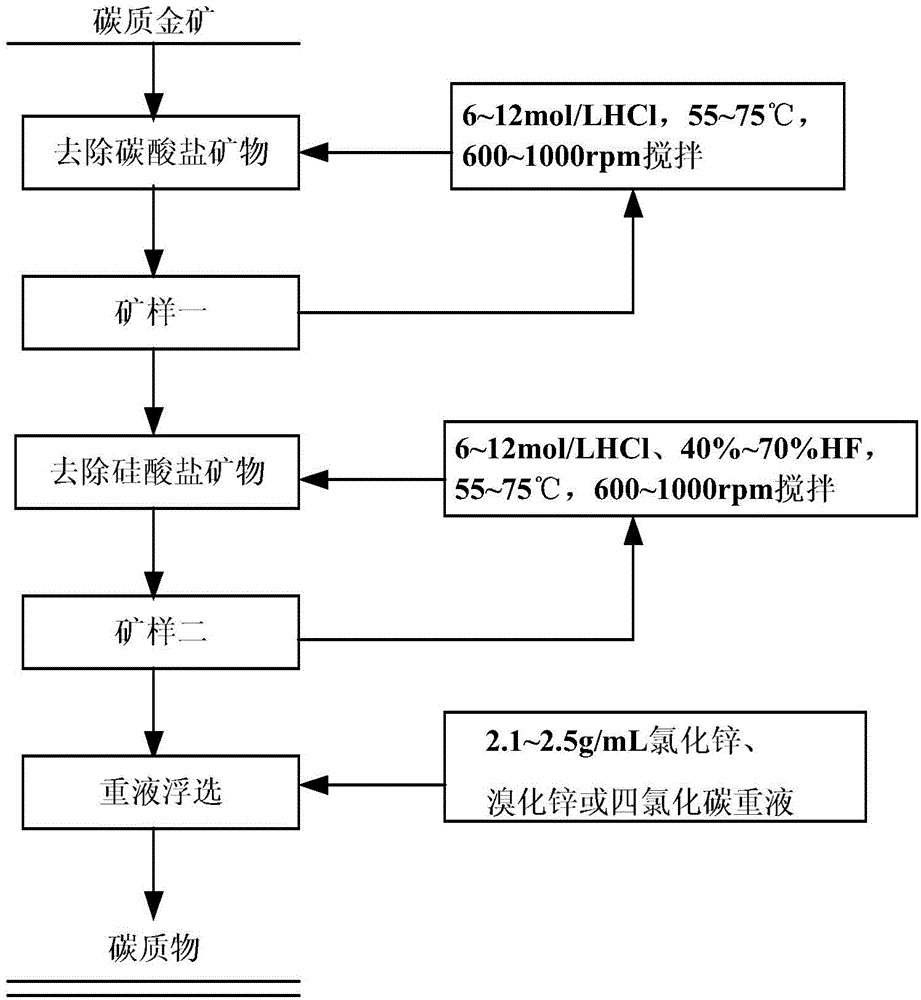Method for extracting carbonaceous matters in gold ores
A medium carbonaceous material and carbonaceous material technology, applied in solid separation, flotation and other directions, can solve the problems of high price, limited synthesis amount of sodium polytungstate, difficult to control the reaction process, etc., to improve the purity, shorten the time, Mitigating the effect of distractions
- Summary
- Abstract
- Description
- Claims
- Application Information
AI Technical Summary
Problems solved by technology
Method used
Image
Examples
Embodiment 1
[0038] The gold ore treated in this example comes from a gold mine in Sichuan. The contents of its main elements are shown in Table 1. The particle size analysis after grinding shows that gold ore samples with a particle size of ≤100 μm account for 80% of the total; The gold-loaded sulfides are pyrite, magnetite and arsenopyrite, and the main gangue minerals are quartz, magnesium calcite, dolomite and muscovite.
[0039] Table 1 Contents of main elements in the gold ore of Example 1
[0040]
[0041] A method for extracting carbonaceous matter in gold ore, comprising the following steps:
[0042] (1) Removal of carbonate minerals
[0043] Add 2mL of hydrochloric acid with a concentration of 12mol / L per gram of gold ore sample, mix the hydrochloric acid and the ore sample, stir at 55°C and 600rpm for 0.5 hours, and centrifuge at 1000rpm for 15 minutes to remove the acid solution;
[0044] Repeat above-mentioned steps 2 times, after adding hydrochloric acid, ore sample no lon...
Embodiment 2
[0056] The gold ore treated in this example comes from a gold mine in Shaanxi. The contents of its main elements are shown in Table 3. The particle size analysis after grinding shows that 88% of the gold mines have a particle size of ≤100 μm; the main gold-carrying sulfide in this gold mine is yellow Iron ore and arsenopyrite, the main gangue minerals are quartz, calcite, dolomite and muscovite.
[0057] The content of main elements in table 3 example 2 gold ore
[0058]
[0059] A method for extracting carbonaceous matter in gold ore, comprising the following steps:
[0060] (1) Removal of carbonate minerals
[0061] According to the ratio of adding 6mL hydrochloric acid with a concentration of 9mol / L per gram of mineral sample, add hydrochloric acid to the mineral sample; stir for 1 hour at 65°C and 800rpm, and centrifuge at 2000rpm for 5 minutes to remove the acid solution;
[0062] Repeat the above steps 3 times, and then add hydrochloric acid, the ore sample no longe...
Embodiment 3
[0092] The carbonaceous gold ore treated in this example comes from a gold mine in Guangxi. The content of its main elements is shown in Table 6. The particle size analysis after grinding shows that 85% of the gold ore has a particle size of ≤100 μm. The gold sulfide is mainly loaded in this gold ore. for pyrite,
[0093] Pyrrhotite and arsenopyrite, the main gangue minerals are quartz, dolomite and muscovite.
[0094] The content of main elements in table 6 example 3 gold ore
[0095]
[0096] A method for extracting carbonaceous matter in gold ore, comprising the following steps:
[0097] (1) Removal of carbonate minerals
[0098] Add 10 mL of hydrochloric acid with a concentration of 6 mol / L per gram of the ore sample, mix the hydrochloric acid and the ore sample; stir for 1.5 hours at 75°C and 1,000 rpm, then centrifuge at 1,500 rpm for 10 minutes to remove the acid solution;
[0099] Repeat the above steps 4 times, after adding hydrochloric acid, the ore sample no l...
PUM
| Property | Measurement | Unit |
|---|---|---|
| particle size | aaaaa | aaaaa |
Abstract
Description
Claims
Application Information
 Login to View More
Login to View More - R&D
- Intellectual Property
- Life Sciences
- Materials
- Tech Scout
- Unparalleled Data Quality
- Higher Quality Content
- 60% Fewer Hallucinations
Browse by: Latest US Patents, China's latest patents, Technical Efficacy Thesaurus, Application Domain, Technology Topic, Popular Technical Reports.
© 2025 PatSnap. All rights reserved.Legal|Privacy policy|Modern Slavery Act Transparency Statement|Sitemap|About US| Contact US: help@patsnap.com



